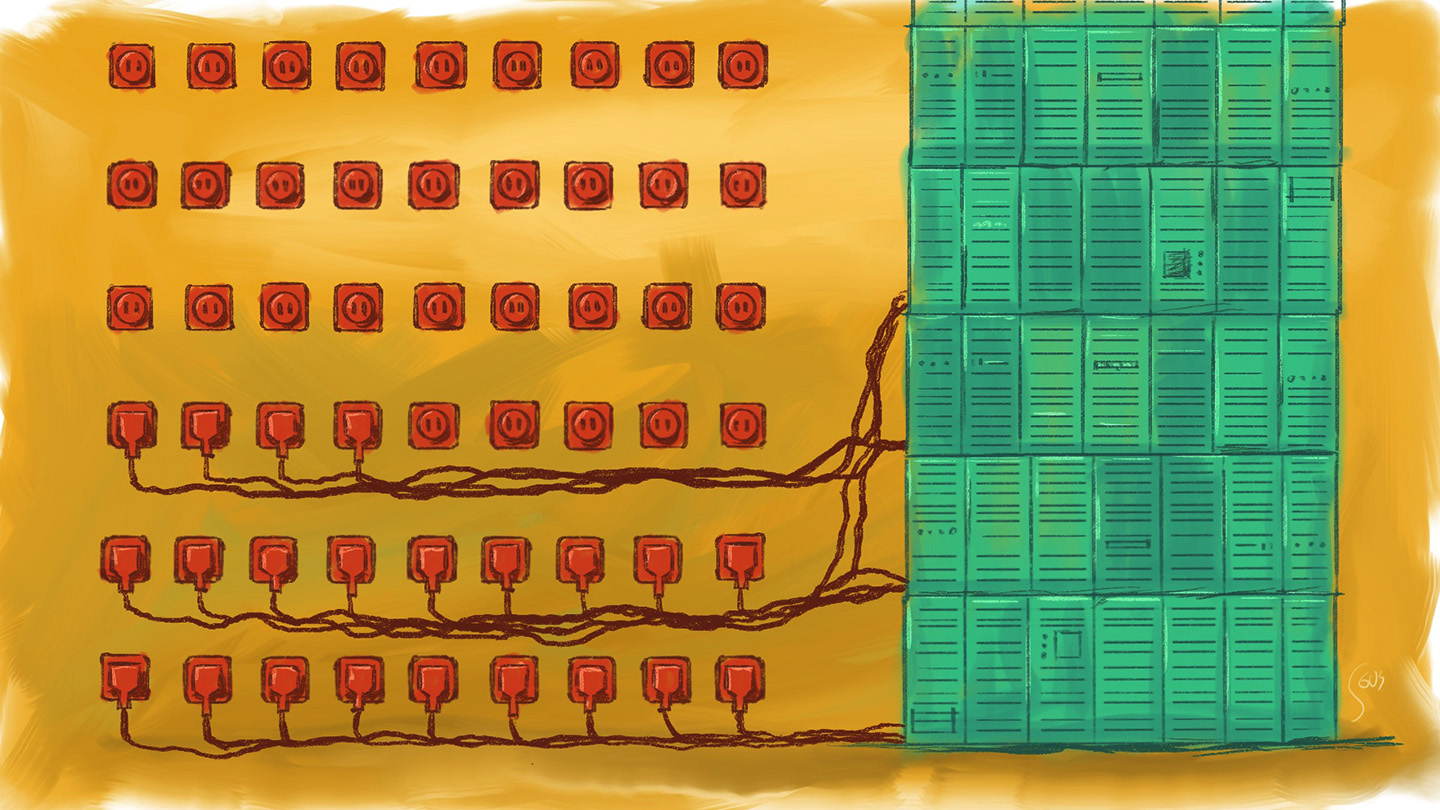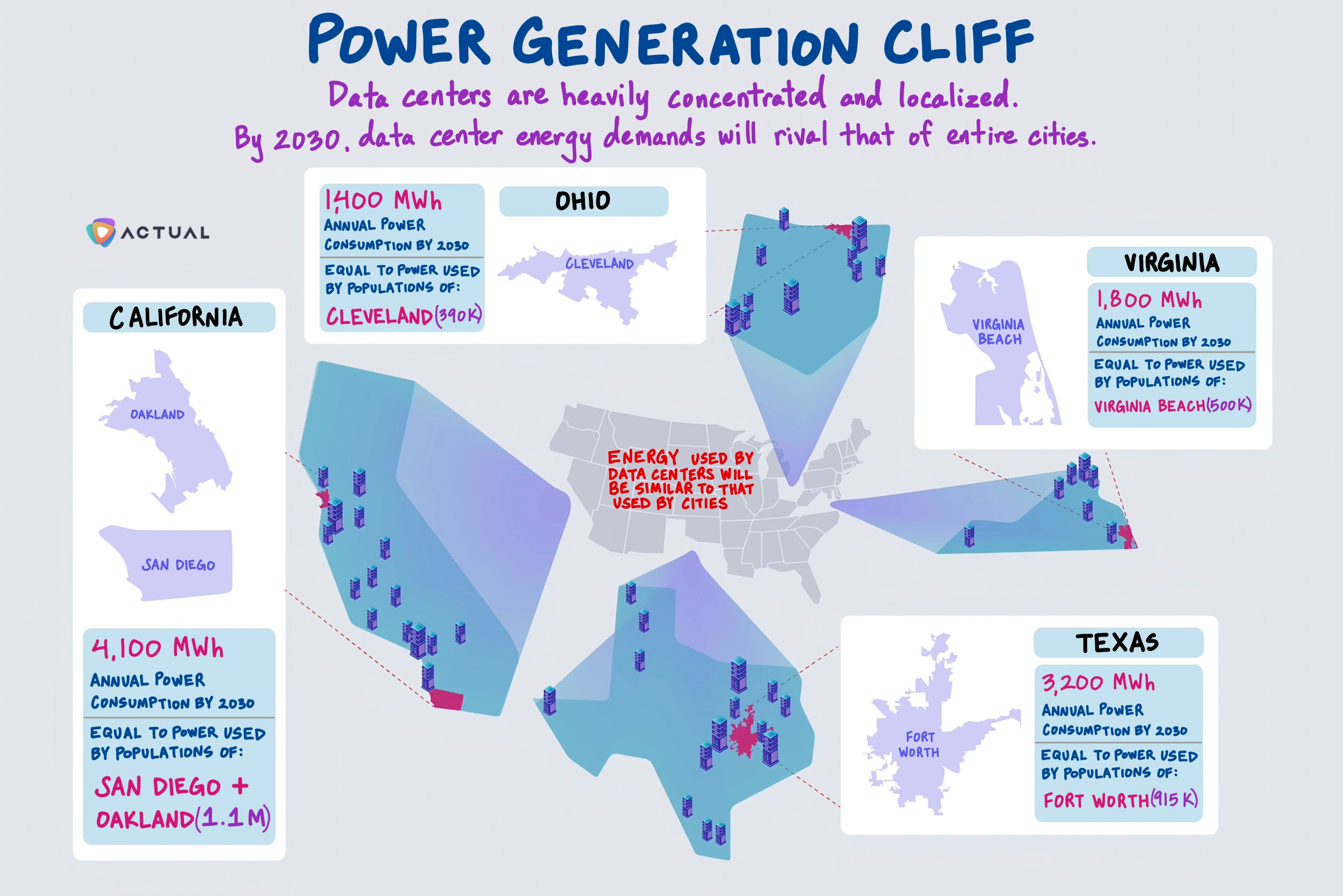
November 16, 2023
The Need for AI-nergy In Our Cities
AI has increasingly become integral to business operations by streamlining workflows and simplifying processes across various sectors, notably impacting industries like entertainment and supply chains. As a result, data centers accounted for 2% of the total energy consumption in the US in 2022.
There are approximately 2,000 active data centers in the US. The nationwide demand for energy to power data centers is projected to increase by 80% by 2030, from 19 GW to 35 GW. The anticipated growth stems from the expansion of AI technology and the development of enormous hyperscale data facilities.
By 2027, AI servers are predicted to consume an annual energy range of 85 to 134 TWh, equivalent to the annual energy consumption of Argentina or Sweden, with growth concentrated in hyperscale facilities that consume 4.5 times more energy than an average data center.
As cloud web services and AI technology continue to evolve rapidly, there is an urgent and growing demand for additional power in localized, regional circuits.
How does this affect you?
Utilities companies need to build accurate, circuit level projections to be able to supply the increasing energy demands of hyperscale facilities.
Data center operators must collaborate with local utilities to ensure that power will be available when needed, while also investing in technologies to provide the same level of compute with less electricity.
Regulators need to set firm environmental standards and requirements for the growing data center market and ensure that demands for increased generation can be quickly met with green, zero-emission electricity sources.

Unlike other energy distribution systems, like EV charging networks, the need for additional power will be unevenly distributed. Data centers are heavily concentrated and localized, meaning significant amounts of energy are consistently distributed to regional circuits to power these buildings. As a result, supplying energy for data centers not only becomes a power generation issue but also a power distribution challenge.
The increased demand for electricity to power data centers will rival some of the country’s largest cities. By 2030, data centers in Ohio alone will see increased demand equivalent to the annual energy consumption of Cleveland. Texas will experience demand equivalent to Fort Worth, Virginia to Virginia Beach, and California to San Diego and Oakland combined.
Fourteen states will see data center consumption grow by enough to power 3% of the state’s population, and the District of Columbia will see over 7%. Unlike these cities with populations spread across large areas, data centers are typically concentrated in areas the size of a large freeway interchange.
Generating more energy will require increased investment in zero-emissions energy production to ensure that AI demand does not drive an overall increase. As mandated disclosure rules and net-zero targets are enforced, companies need to ready themselves for the imminent transition towards regulated green investments. What can data centers do to minimize their energy use and emissions?
Strategic Planning. Some states still rely on fossil fuels to generate electricity, affecting Scope 2 emissions. Data center operators must proactively assess the costs and risks tied to their power generation assets over the next 10 to 20 years, especially with increasing net zero mandates and reporting requirements.
Wholesale energy. Data centers must increase their use of Power Purchase Agreements (PPA) to directly invest in renewable energy sources, thereby bolstering the infrastructure to meet future demands in these regions.
Energy-efficient technologies. With the rapid expansion of hyperscale facilities, technology companies must prioritize investments in energy-efficient practices, particularly in cooling systems and servers, which account for approximately 80% of energy consumption.
The acceleration of AI and other technologies is thrilling. Machine learning and cloud data services are changing the course of every industry, evolving at a scale and speed we have never seen before. However, as we transition towards an electric future in “everyday things'' and at a large scale, addressing energy generation and distribution becomes ever more urgent. The need for energy infrastructure extends beyond sustainability efforts and reporting.
In the worst-case scenario, if our energy infrastructure falls short, will we prioritize that additional 1% to power a hyperscale data center that drives our economy or provide electricity to 700,000 households? Let’s hope we don’t have to find out.
More recent newsletters
April 25, 2024
ACTUAL
Catalonia, Spain, has recently declared a drought emergency as reservoirs plunge to critically low levels at just 15% of full...
April 11, 2024
ACTUAL
The automotive industry has been undergoing a drastic transformation, transitioning from combustion engine vehicles to include EVs, hybrid engines, and...
March 21, 2024
ACTUAL
The thrilling races of Formula 1 are powered by behind-the-scenes innovation, where even the slightest tweaks in aerodynamics or engine...


